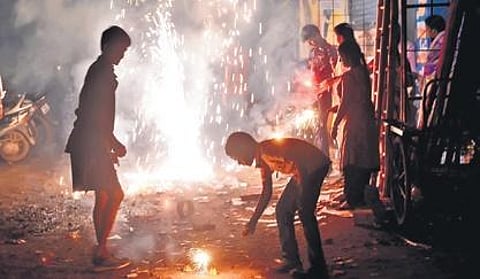

CHENNAI: In the beginning, there is paper. Your bijili and rockets and several other crackers begin with a paper casing. Over issue textbooks, printing waste and used paper from the southern states make it to the district for the first stages of processing. In case of crackers like flower pot, the casing is a strawboard from grinding hay and paddy husk together.
1. Day three is the one for the filling. For the bijili and rocket, the base is closed off with sand (red and sedimented) and gum in the first step. It’s then dried for an entire day. On day-five, the 800-odd tubes of bijili, say, stacked inside an aluminium ring is covered with a tissue paper on top. Then, holes are made above each individual piece to ensure that the chemical filling it’s about to receive does not touch the outer surface. It is then sent to the chemical room. For the flower pot, the process varies slightly. It’s first covered in tissue and sent to the chemical room. Once it’s packed, the filling is secured and the bottom is sealed off with sand and gum.

2. This paper is then processed by hand by mostly women workers. The cottage industry section of the assembly line is where the paper is painted, dried, cut to size and sent to the factory, neatly arranged by the hundreds and thousands in aluminium rings. For the flower pot, it’s the purchases strawboard that sets off the process. This is scored and put through wooden moulds to get the quintessential pot base. This is dried out in the sun before being stacked and sent to the factory.
4. In the next step, the cracker is fitted with a fuse. It’s sundried a full day before being sent for packaging. The flower pot gets a speciallymade ‘twinkling star’ fuse. The top and bottom parts of the pot are then covered with coloured tissue paper before being slapped with the company’s branding labels. This is dried in the shade and then exposed to the sun to ensure that the label doesn’t fade out; then, it’s sent packing.
5. Depending on how far the destination is, the crackers arrive at retail stores anywhere between one and 10 days.
6. Post-revelery, the particle matter (PM) and gases released into the air remain hover over the city for long. Last year, the Central Pollution Control Board (CPCB) recorded a poor Air Quality Index (AQI) in the city on festival day and the next.
7. While the permissible noise level is 45 to 65 dB(A), depending on area classification, cities usually record a higher level of noise pollution on Deepavali day. Last year, Chennai ranged between 67 to 84 dB(A).
8. The debris from the crackers that usually litters every street during the festival eventually makes
its way to the heavily compromised sewer system or a landfill (thanks to days of labour by sanitation
staff).

At every stage,
the products are tested for safety and accuracy. The waste generated throughout the process is processed
and disposed of on a daily basis.
Paper — one of the primary raw materials — is sourced from printing hubs in Sivakasi, Chennai and the likes. Used paper also comes from the neighbouring states of Kerala, Andhra Pradesh and Karnataka. The closer the source, the lesser the transportation cost.
COVID or not, the business has always been classified as hazardous work. Most of the processes requires painstaking manual labour — one that is usually executed in the cottage industry set-up. People
continue to dabble in chemicals without the use of any protective gear like masks or gloves. It’s common enough to see the workers dine in the same room they work in.
Chemical essential, potassium nitrate, is sourced all the way from Haryana. Synthetic versions of it are found closer to home in Mysuru and a few other cities. Aluminium powder comes from Thirumangalam in Madurai district. Sivakasi itself is home to Asia’s largest unit and the company gets the chemical from there too.